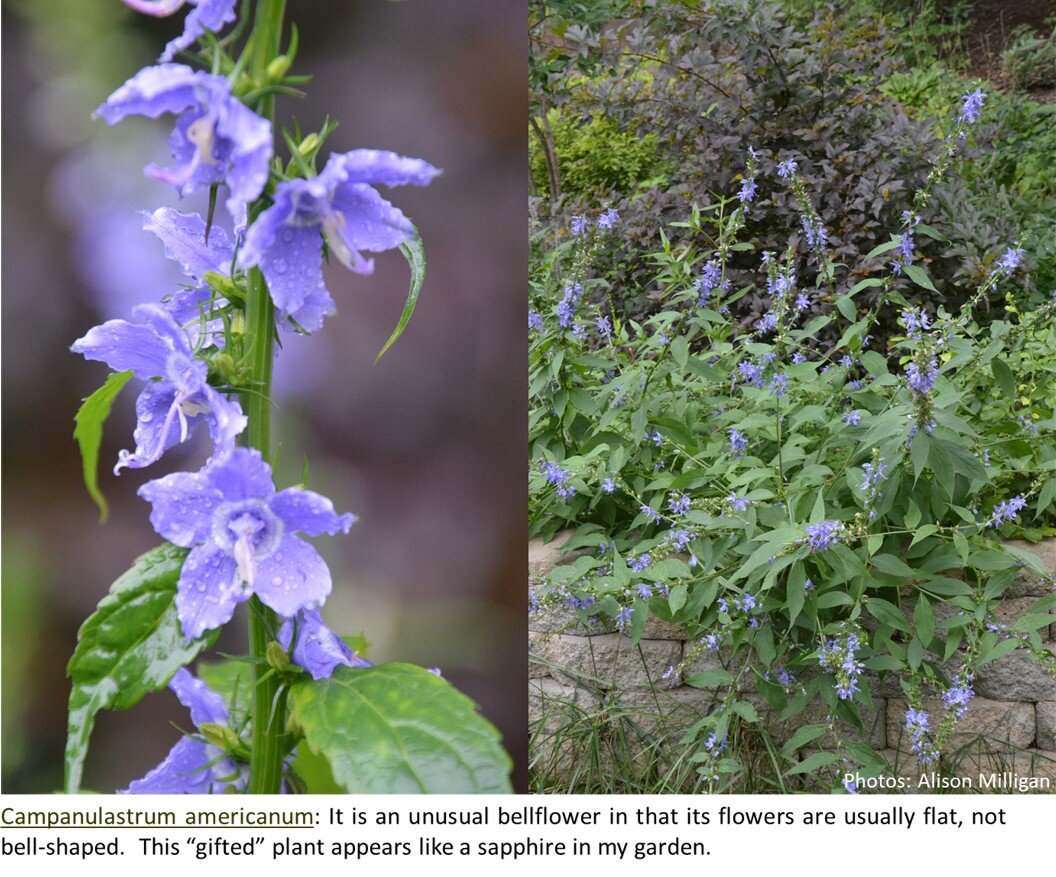September’s Native Maryland Plant
Campanulastrum americanum
L. (kum-PAN-you-luh-strum uh-mair-ih-KAY-num)
Common Name: American or tall bellflower
My birthday is this month, and the birthstone in September is sapphire which can be many colors but is usually associated with blue, very close to the color of Campanulastrum americanum – my new favorite plant. When it’s your birthday you often do a bit of reflection on where you’ve been and how things are going: Health okay? Keeping your mind busy? Spending quality time with family and friends?
In mid-April, I visited my good friend Judy Fulton at her home. Judy was kind enough to give me some Lindera benzoin (spicebush) saplings for my community. As I was leaving her house and walking to my truck she said, “Wait a minute Alison”, she nonchalantly reached down and gently pulled a 4” plant from the ground and handed it to me. “This is one of my favorite’s”, she said, “I think you’ll like it too.” I thought to myself “that’s nice Judy”, but for those of you who know Judy Fulton you know she loves native plants - seemingly all native plants - so she could have just handed me a Rudbeckia hirta (black-eyed Susan). I went home and busied myself planting the saplings, I almost forgot about this mystery plant; it wasn’t until early May that I made a home for it in my garden.
Getting back to sapphire: sapphire is formed from the mineral corundum, normally drab and grey - also the second hardest mineral after diamond. This little 4” plant Judy handed me, seemed kind of like corundum to me (even a conundrum) – not much to look at, at least not in April. Like corundum, however, this plant turns out to be a sapphire in the garden – a real stunner - when it’s in its gem form; (in June-August, maybe even September if I’m lucky). The light blue, star-shaped flowers appear in clusters or solitary in the axils of the upper lance-shaped leaves. And oh, just look at that style with its three-lobed stigma!
Campanulastrum americanum is a biennial (blooms in its second year then dies), but will easily remain in a garden by self-seeding. I’ve already weeded around my specimen hoping it reseeds aplenty so I can enjoy its beauty for many years to come.
As my birthday nears, I know I have a multitude of people and things to be grateful for; Campanulastrum americanum and Judy Fulton are both high on that list.
Genus campana comes from Latin and means “bell” in reference to the bell-shaped flowers. Species means from America, North or South. NOTE: This plant was previously known as Campanula americana L. but was reassigned to its own genus because of the unique structure of the flowers.
~ Alison Milligan – Mstr. Gardener/Mstr. Naturalist/Mstr. Watershed Steward
Chesapeake Bay Landscape Professional (CBLP)







